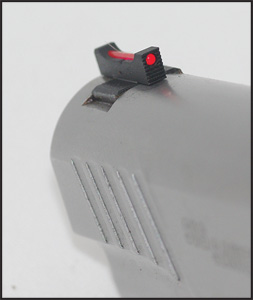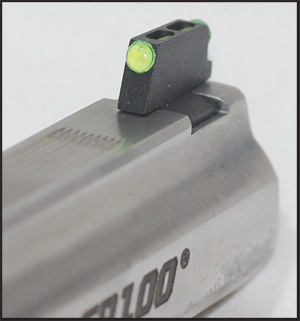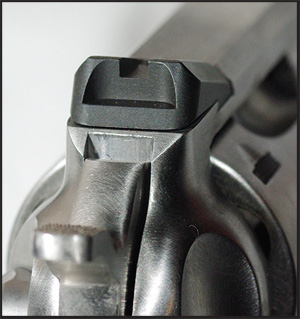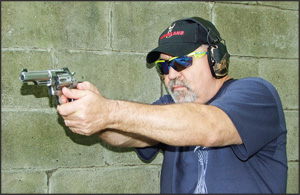by Scott Smith | Contributing Editor
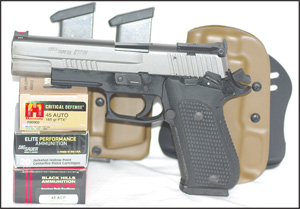
Sig 220 Single Action Only Super Match with its test ammunition and Blade Tech holster and double mag pouch; all are suitable for competition or self-protection.
I have spent most of my life carrying a handgun on duty, as well as for personal protection or competition. My first experience with handguns was a .22LR revolver that my dad owned; it was fun and easy to shoot. When I was old enough my godfather allowed me to shoot the 1911 he carried in Korea. At the young age of 12 I was hooked on handguns.
Over the years, Uncle Sam issued me K-framed revolvers, 1911s, Berettas, and Sig Sauer pistols. All of these performed well and I never felt under-gunned no matter the duty assignment. As I got older and could afford to purchase my own handguns my preference for handguns seemed to be those from Sig or almost any 1911. Revolvers just never really caught my eye but I do own them, just because a gun person is supposed to.
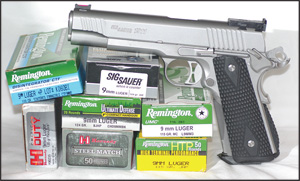
If you prefer a 9mm 1911, Sig’s Traditional Match Elite (TME) is practically perfect. It ran flawlessly and accurately with all its test ammunition.
In my late twenties I learned of a sport called “action pistol shooting,’ specifically IPSC/USPSA, and started shooting. My first handgun for this was a used Hi Power. It pointed like a 1911 and held 13 rounds of 9mm, and was affordable. You give up points with the 9mm because it is considered a minor power factor load. Being a novice action pistol shooter, I was giving up lots of points; I needed a 45. I found a well-traveled Browning BDA, the first style of Sig Sauer P220 to be imported into the country. The pistol was a .45, accurate and ran flawlessly but the European heel magazine release cost time during reloads. Shooting major power factor, my scores did improve. About this time I became more involved in USPSA and my background as a former USAF Reserve Security Policeman gave me credibility to start writing for several magazines.
My writing afforded me the opportunity to shoot many firearms, among them a used Ruger Security Six, most of the popular semi-automatic pistols of the last couple of decades, and many customized 1911s. The 1911s became my passion and my vault filled with several of them. I gravitated to 1911s because you could have a 1911 built to meet your needs. Back in the 80s and 90s there was no such thing as a competition ready 1911.
I continued shooting competitively and this new game—IDPA—came about. At the urging of my mentor, Walt Rauch, I sent Bill Wilson a check and became a charter life member. This game was/is a good combination of skill, some “tactics,” and you could shoot duty firearms like Sigs and be competitive.
Thanks to IDPA, my vault filled with my other pistols of choice: Sig Sauer’s P226 and 229. These in my opinion were/are the ideal Stock Service pistol and mine allowed me to place very well at several matches. The P226/229 also fit well into USPSA’s Production Division, which meant I could run my duty gun and compete in both games.
Both games have grown and the manufacturers started building pistols that could be competitive out of the box. Fortunately for me and my Sig addiction, Sig Sauer (18 Industrial Dr., Dept. TGM, Exeter, NH 03833; phone: 603- 610-3000) is one of the companies meeting competitive shooters’ needs. Two of the pistols Sig offers that are match ready are the P220 Single-Action-Only Super Match and Traditional Match Elite (TME) 1911. The 220 is chambered in .45ACP, the TME 1911 is offered in 9mm, .40S&W and .38 Super; all popular calibers in action shooting.
Sig’s 220 series has been a popular-pistol for law enforcement, personal protection, and competitors who liked traditional DA/SA actions. However, a single action is easier to shoot and most single actions are quicker because of the shorter trigger reset. A fast trigger reset in competition is important because thousands of a second add up in a match and the trigger of the 220SAO Super Match rivals most 1911s.
What sets the 220 Super Match apart from untuned 1911s is that it runs on whatever ammunition you feed it, right out of the box. On its first trip to the range, the 220 fired several hundred rounds of semi-wadcutter, flat point and truncated jacketed ammunition without a problem. I will caution those who load their own ammunition, you have to load rounds to factory specified length. You cannot load rounds long like many folks do for 1911s or they are a bear to get in the magazine.
What makes this whiz bang 220 so special? First it is a Sig Sauer pistol, known for having to-hell-and-back reliability. Sig pistols function in the worst of conditions with the crappiest of ammunition; which is why agencies such as Texas DPS/Rangers, the USCG, FAMs, ATF, and many others issue them. These same agencies issue them for their accuracy and with the new E2 grip they fit a wide range of hand sizes.
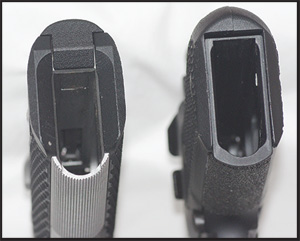
The mag wells formed by Hogue’s G10 Extreme Grips; the magwell of the 1911 looks like it was custom fit.
Next the 220 SAO SM has a 5-inch barrel with match grade accuracy and seems to give optimal performance of .45 ACP cartridges. You have nearly seven inches of sight radius from the stainless slide topped with Sig’s proprietary adjustable rear sight and a white dot front. This gives you a clear sight picture to help you get the most out the accuracy of the pistol.
With its single-stack alloy frame the 220 fits most people well. Sig adds a beavertail to aid in recoil management and custom hardwood grips with front strap checkering to ensure a solid purchase on the pistol. Controls of the 220 are where they should be, frame mounted. The safety is ambidextrous and is slightly extended for easy manipulation. The slide has front and rear cocking serrations to make loading and clearing the pistol easy. If you are using the 220 SAO SM for duty or 3-Gun competition, the frame has a machined Picatinny rail so you can mount a light.
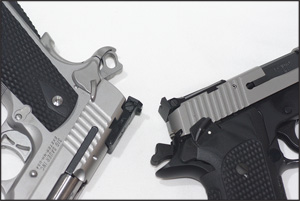
You can see the ambidextrous safeties, proprietary adjustable rear sights, Hogue’s G10 Piranha Grips, and Sig’s external extractors; which help make these pistols reliable.
One feature of the 220 that is often overlooked is the magazine. It is a single column magazine which feeds whatever bullet design you prefer. Unlike 1911s, the Sig 220 magazine uses a magazine pad. This extends the overall grip length by approximately three-eighths of an inch, making it easier for those with big hands to seat the magazine. Contrary to popular belief, the magazine pad does not affect how the pistol conceals; thanks to the rounded butt of the grip.
To carry the 220, I chose a Blade-Tech OWB and matching double magazine carrier. What I like about this holster is you have a choice of mounting options; belt slide, paddle, Tek-lok and others. My rig will use the adjustable paddle on the holster and Tek-lok on the magazine carrier. This set-up allows for easy off and on, since this is primarily a competition pistol, keeps the pistol secure and allows for a fast smooth draw stroke.
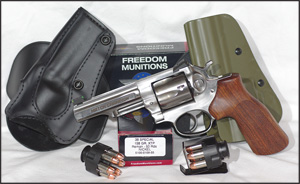
Ruger’s GP100 Match Champion ready for the range with Safariland holster, speedloaders/holder, Freedom Munitions Ammunition and Blade Tech holster.
With the competition rig carrying the Sig 220 SAO Super Match it was time to see how well this pistol performed. For accuracy work Sig’s new Elite Performance 230-grain hollowpoints, Black Hills (PO Box 3090, Dept. TGM, Rapid City, SD 57709; phone: 605-348-5150), 230-grain hollowpoints and 200-grain lead semi-wadcutters, and Hornady’s (3625 West Old Potash Hwy., Dept. TGM, Grand Island, NE 68803; phone: 800-338-3220)185-grain Critical Defense loads were used. These loads all have excellent down range ballistics and even the 200-grain semi-wadcutters will do as self-defense ammunition in a pinch. As I had expected the semi-wadcutters were the most accurate, but by the barest minimums. With this selection of ammunition, the 220 consistently fired sub 2½” groups at 25 yards; even when the magazine had a variety of loads in it. There were no feeding issues; as anticipated the 220 was boringly reliable. A good thing for a competition and duty pistol!
If you are traditionalist, then you will like the Traditional Match Elite 1911 in 9mm. This 1911 is an all stainless steel pistol which makes the pistol impervious to the worst weather conditions. To ensure the pistol gives you a good purchase the front strap has crisp factory checkering, dark checkered custom wood grips and checkered mainspring housing. For ease of operation the TME ships with extended ambidextrous controls. The safety and slide stop are sized to be easy to operate without being so large they snag clothing. These are standard features that you would expect on a custom 1911, not a factory pistol.
To ensure you can operate the slide with wet or cold hands, there are front and rear cocking serrations. All of the sharp edges have been beveled so you don’t tear up your holsters or hands during clearing drills. Sig installs a rugged adjustable rear sight with two dots to match the single dot on the front post.
Unlike most 1911s, the TME completes the slide assembly with a short plug and flat wire recoil spring not a full length guide rod. Some will argue that this is a poor system, because the spring kinks. In 20+ years I have never seen a 1911 recoil spring kink or fail to operate properly, with the flat spring that should be virtually impossible. The short plug allows you to clear jams that you could not otherwise quickly clear. On more than one occasion, because of old case failures, I have cleared a 1911 using a door or window frame. The short plug allows you to use the guide rod area of the slide to gain this leverage; with a full length guide rod you cannot do this.
The TME ensures reliable case extraction by using a spring-loaded external extractor. This has been a point of contention with purists for years. In non-45 1911s, proper extractor tension is vital and this set-up ensures the extractor has consistent tension every time. In the short time I have been running this 1911 it has had several thousand rounds shot through it on a square range and in USPSA competition and there have been zero failures to extract or feed properly. If this system works on Sig’s other duty weapons, there is no reason to poo-poo it on their 1911s.
For testing, we used several offerings from Hornady, Remington and Sig’s Elite Performance line. The ammunition we used had bullet weights from 115 grains to 147 grains, including full metal jacket, hollowpoints and frangible. From its first trip to the range the TME showed no preference for bullet weight or ojive design. Accuracy right out of the box was point of aim-point of impact at 25 yards with all bullet weights. Sig has taken its years of experience from building duty pistols and somehow put it in this 1911 and built a pistol that simply performs well. This pistol consistently fired sub-3” groups all day long. The best group was fired with Sig’s Elite Performance 124-grain hollowpoint and Remington’s (870 Remington Dr., Dept. TGM, Madison, NC 27025; phone: 800-243-9700) 100-gr. Disintegrator frangible cartridge with groups averaging 2.25”, Hornady’s 125-grain HAP load was close at 2.5”.
To ensure the TME fed ammunition reliably, Wilson Combat (2234 CR 719, Dept. TGM, Berryville, AR 72616; phone: 800-955-4856) ETM ($36.95) and Tripp Research (515 Kelley Rd., Dept. TGM, Bastrop, TX 78602; phone: 877-837-9445) 9mm-RG ($36.95) magazines were used. Both of these magazines hold ten rounds and have been proven to be 100% reliable. Tripp offers a weighted base pad to ensure their magazine falls free every time.
These pistols are practically perfect out of the box and with two changes they really are. First for my over-50 eyes, I installed 0.100” fiber optic sights from Dawson Precision (3300 CR 233, Dept. TGM, Florence, TX 76527; phone: 254-793-0150). It has been my experience this size sight gives me a fast, accurate sight picture under stressful conditions.
Next the factory grips were replaced with Hogue’s (550 Linne Rd., Dept. TGM, Paso Robles, CA 93446; phone: 805-239-1440) Extreme G10 Grips with Piranha texturing. The TME had the black Magrip kit ($119.95) with arched mainspring housing installed. This grip gives you a flush fitting magwell, so there is no need to have one fitted. This is the slickest set of grips I have used on a 1911. The Super Match sports the 220 version of the G10s. On the 220 the bottom of the grip mates perfectly with the magazine pad, giving you a clean smooth look. If you are looking for match, carry or duty-ready pistols look no further than Sig Sauer.
If you are looking for a match ready revolver, look at the latest offering from Ruger (411 Sunapee St, Dept. TGM, Newport, NH 03773; phone: 603-865-2442)—the GP100 Match Champion. A match ready revolver is something those who shoot Stock Service Revolver in IDPA need. The GP100MC is an affordable handgun and competitive out of the box, with an MSRP of $899.
I am not a big revolver shooter, but they do hold that mystique of being a “six gun.” A revolver was also my first issue sidearm so wheel guns do have a touch of that nostalgia. The GP100MC has that feel of an old school six shooter enhanced by modern refinements.
Ruger trims weight off the GP100 with a half barrel lug instead of the full length lug. This allows the shooter to transition from target to target quicker. When shooting .38 special loads, recoil is mild. Even with full house .357 magnum loads the GP100MC is more than manageable. The custom stippled Hogue grips further enhance the handling of the GP100MC. With their angle, these grips allow the pistol to point naturally for most shooters. When combined with the 4.2” and 11 degree crowned barrel, you have a revolver that is more accurate than most of us will ever be able to shoot.
Ruger installs a Novak low mount rear sight to give a crisp clear sight picture. To further enhance the sight picture, a dovetailed fiber optic front sight is standard. Out of the box my sample was point of aim/point of impact with Freedom Munitions’ (17482-B Northwest Freeway, Dept. TGM, Jersey Village, TX 77040; phone: 208-746-3668) 158-grain XTPs and consistently fired sub 3” groups at 25 yards. Thanks to the factory tuned trigger, there was no trigger jerk or staging when fired double-action. When fired double-action, the trigger pull is 10 pounds and in single-action it breaks as crisp as a 1911 at 4.5-4.8 lbs. I am sure with use this will only improve.
Support gear for this piece is readily available from Safariland (3120 E. Mission Blvd., Dept. TGM, Ontario, CA 91761; phone: 800-347-1200) and Blade Tech (5530 184th St. E, Dept. TGM, Puyallup, WA 98375; phone: 877-331-5793). The 568 Custom Fit holster ($53) from Safariland and Blade-Tech’s OWB ($64.99) fit and conceal the GP100MC perfectly. To keep the revolver loaded Safariland offers speedloaders ($12) and holders ($20) that conceal well, function flawlessly and, thanks to the spring release, give you a quick reload. The chamfered cylinder prevents rounds from catching on the lip as you feed them with the speedloader.
Ruger’s GP100 Match Champion is an improved version of the time tested GP100. With the improved trigger, lighter weight, great sights and tank like construction, this revolver should endure the hardest competitors in the harshest conditions. The GP100 MC would also make a fine house gun or daily carry piece. I look forward to running it in IDPA next year.
Hopefully we gave you a few ideas for solid out of the box competition, daily use handguns. Once you have a new piece, get out to the range and shoot. Get involved in action shooting; you will make friends, have fun and become more proficient with your firearms. Remember to shoot straight, shoot safe, have fun and support the Second Amendment Foundation and NRA to ensure we continue having the right to keep and bear arms.

